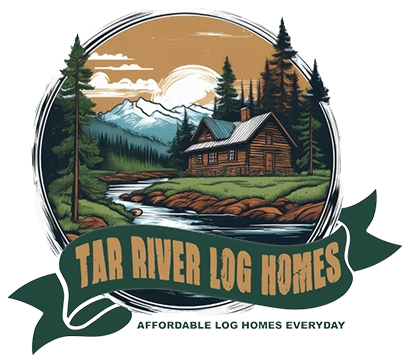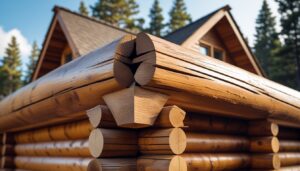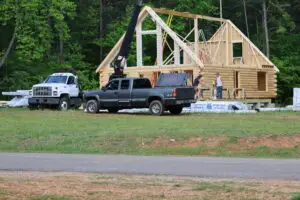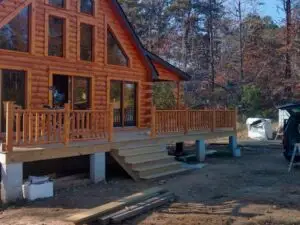If you’ve been dreaming about a log home, one detail can make or break its comfort and strength: the corner joinery. Dovetail corner log homes use angled cuts to lock logs tightly, making the design durable against weather and time.
This method has been trusted for centuries, thanks to its durability and natural energy efficiency. It’s not just about looks—the dovetail shape seals out drafts and moisture without needing lots of hardware.
At Tar River Log Homes, we believe building a cabin shouldn’t feel overwhelming or overpriced. That’s why we supply high-quality logs designed to fit snugly in dovetail style, keeping the process simple and affordable.
In this guide, we’ll cover what makes dovetail corner log homes unique, why they’ve stood the test of time, and how they compare to other joinery methods.
What Are Dovetail Corner Log Homes?
Dovetail corner log homes use a unique way to fit logs together tightly at the corners. This joinery’s got a long history and some pretty specific features that make these homes sturdy. Once you see how these corners work, it’s obvious why so many trust them for solid log buildings.
Defining Dovetail Corner Joinery
Dovetail joinery means you cut the ends of logs into angled, interlocking shapes—wide on one side, narrow on the other, kind of like a bird’s tail. Stack the logs, and they lock together like puzzle pieces.
This design does away with the need for nails or metal fasteners. It keeps your walls from shifting or pulling apart. The tight fit also helps block wind and water, so your home’s more weatherproof.
History and Tradition of Dovetail Corners
People have been using dovetail joinery for hundreds of years. Early American and European settlers leaned on this method for building log cabins and homes. They liked it because it made for strong, long-lasting buildings with just wood and a few basic tools.
You can still find old cabins with dovetail corners holding tight after all these years. That says a lot about the skill and care those early builders put in. Using dovetail corners ties your log home to a deep tradition of American craftsmanship.
Key Features That Set Dovetail Corners Apart
What’s special about dovetail corners? Their shape and strength. The angled cuts lock the logs firmly—unlike square or saddle-notch corners, dovetail joints don’t let logs slide or shift.
You end up with tight corners that barely shrink over time. The look is neat and smooth, giving your home a classic, crisp finish. Logs can be cut for a perfect dovetail fit, giving you reliable quality from the start.
Benefits of Dovetail Corner Construction
Dovetail corner construction creates strong joints that keep logs locked together. This technique means your home stays solid and well-insulated. Plus, you get that unmistakable look of real craftsmanship—your log home will feel sturdy and welcoming.
Structural Stability
Dovetail joints use interlocking shapes, which stop the logs from shifting as time goes by. Your home stays square and secure, even while the wood settles. That means fewer gaps, so drafts and moisture stay outside.
The angled cuts in dovetail corners hold everything together without a bunch of nails or screws. You get a durable frame that handles strong winds and heavy snow. These tight joints provide long-term strength when crafted well.
Improved Energy Efficiency
Dovetail corners fit snug, blocking air leaks better than most other corners. With no gaps for cold or heat to sneak in, your home stays warmer in winter and cooler in summer. That’s money saved on energy bills.
Logs insulate naturally, but dovetail construction gives you an extra layer of tight sealing. Add some good chinking, and you keep drafts and moisture at bay. You end up with a comfortable, dry home without cranking the heat or AC all the time.
Aesthetic Appeal
Dovetail corners give you sharp, clean lines at every corner. That’s the kind of detail that shows off traditional craftsmanship and a classic log home style. The visible joinery adds character without extra trim or fuss.
The angled cuts make a smooth, good-looking profile outside. Since the fit is tight, you won’t see much splitting or shrinking, so it keeps its charm for years. This tidy design works well for both rustic and modern log cabins.
Comparing Dovetail Corners to Other Log Joinery
When you’re weighing different ways to join logs, you care about strength, how easy it is to build, and how long it’ll last. Dovetail corners give you a tight fit and strong hold, but other joinery styles have their own quirks.
Dovetail vs. Saddle Notch
Dovetail corners have that trapezoid shape, locking logs together tightly and keeping your walls square—no extra fasteners needed. The angle even helps water run off, so there’s less chance of rot.
Saddle notch joinery uses curved notches, so logs just sit on top of each other. It’s easier to cut, so some folks find it more beginner-friendly. But saddle notch joints can settle more, so you might need to adjust things as the logs shrink.
If you want strength and a crisp look without a bunch of ongoing work, dovetail is usually the better call. Saddle notch might save you some cash up front, but you could spend more time maintaining it.
Dovetail vs. Butt and Pass
Butt and pass is the simplest—logs just butt up against each other, no interlocking. It’s fast and cheap to build.
The downside? Less stability. Since the logs don’t lock, you have to rely on spikes or screws. You might see gaps or movement as the house settles.
Dovetail corners win for strength and weather-tightness. If you want a home that needs less fussing over time, dovetail beats butt and pass.
Longevity of Different Joinery Methods
Dovetail corners tend to last longer because the tight fit keeps weather and shifting at bay. The design helps keep rain out and logs locked for decades. Saddle notch joints can go the distance, but usually need tightening or chinking every so often.
They might settle unevenly. Butt and pass homes often need extra work to stop gaps and air leaks. If the fasteners give out, the corners can loosen up.
Quality materials make any joinery style stronger, but dovetail corners usually mean fewer headaches as the years go by.
Building a Dovetail Corner Log Home
Building a dovetail corner log home means you’ve got to pick quality logs, follow a clear construction process, and use the right tools. These steps help your home stay strong, last longer, and look great.
Selecting Quality Logs
You want logs that are straight, dry, and don’t have big knots or cracks. Eastern White Pine is a favorite—it’s strong but not too heavy. Go for kiln-dried logs so they don’t shrink or warp after you build.
Look for tight grain and even diameter. Logs that are too green or uneven can cause headaches later. You need logs that fit together well for tight dovetail joints and sturdy corners.
Kiln-dried logs cut to precise measurements make dovetail joints easier to assemble. Picking quality logs from the start saves you money and keeps your home energy-efficient.
The Construction Process
Start by laying your first course of logs on a solid foundation. Each corner log gets shaped with interlocking tails and pins that fit together snugly. This locks the logs in place and stops them from shifting.
Stack the logs one at a time, making sure each fits tightly and is level. You might need to chink or seal gaps between logs to keep out drafts. Once the walls are up, add roof beams and frames for windows and doors.
Patience matters here. A well-built dovetail corner gives you a solid structure and crisp corners that can last for generations.
Common Tools and Techniques
You’ll need hand tools like chainsaws, chisels, and drawknives for shaping logs. Power tools—routers, planers—speed things up and make the logs smoother.
Cutting dovetail joints takes careful measuring and marking. Some builders use templates for the tails and pins. If your logs fit right, you won’t need nails or screws at the corners—the joint does the work.
Use lifting tools or equipment to move heavy logs safely. A level and a plumb line help keep things straight. Materials cut with precision make dovetail builds smoother and faster.
Design Ideas for Dovetail Corner Log Homes
When you plan your dovetail corner log home, you’ll want a style that feels right, an interior that works for you, and exterior finishes that protect the place. Each choice helps make your log home yours—strong and good-looking.
Modern vs. Rustic Styles
Go for a modern style if you like clean lines, big windows, and open spaces. Mixing wood with metal or glass gives a bright, airy feel. It’s great if you want something simple and open.
A rustic style leans into rough-hewn logs and cozy spaces. Think exposed beams, stone fireplaces, and warm colors. Rustic homes usually have smaller windows and earthier tones. Both styles use dovetail corners for strength, but your pick shapes the mood.
Interior Layout Considerations
Think about how you actually live. Open floor plans give you space for family and friends, while separate rooms give privacy. Maybe you want a big kitchen or a little reading nook. Log walls insulate well, so you won’t need to run the heat or AC as much.
Plan your windows to let in the sun but keep the place efficient. Storage matters. Built-in shelves or lofts can add space without crowding the main floor. Materials are available for both simple and detailed layouts, depending on your design goals.
Popular Exterior Finishes
Your log home’s outside needs to stand up to weather and still look good. Lots of folks go for clear sealants to show off the wood and keep out moisture and sun.
Stains add color and hide small flaws, but let the grain show. Pick from light tans to deep browns—whatever fits your taste.
Some people paint for more color options, but you’ll have to repaint more often. Make sure whatever you use lets the logs breathe so moisture doesn’t get trapped.
Regular upkeep is important. Use finishes that are easy to apply and follow the care tips. Logs can be treated with a variety of finishes to maintain lasting beauty.
Maintenance and Longevity of Dovetail Joinery
Taking care of dovetail joinery keeps your log home strong and looking good for years. You’ve got to keep the wood safe from weather and bugs, and check the corners every so often to catch any issues early.
Maintenance Costs Over Time
Even the strongest corners need care. The Family Handyman notes that sealing, staining, and checking for pests are essential to keeping log homes in shape. Dovetail corners require less shifting repair than butt-and-pass. However, you’ll still need to budget for sealing every few years and occasional log touch-ups.
Protecting Against Weather and Pests
Dovetail joints lock logs tight, but water and bugs can still sneak in over time. Use a solid wood sealant every couple of years to stop moisture from soaking in—that’s what leads to rot or warping.
Keep gutters and rooflines clear so rain runs away from the logs. Trim bushes and trees close to the house to cut down on dampness and keep pests away.
Check for termites and other pests at the base and around corners. If you spot signs, treat it quickly. Regular upkeep helps reduce risks and keeps dovetail joints strong for decades.
Annual Inspection Checklist
Take a little time each year to look over your dovetail corners. Watch for cracks, gaps, or soft spots in the wood.
Check for:
- Water stains or mold
- Loose or shifting logs
- Signs of bugs, like holes or sawdust
- Peeling or worn-out sealant
A flashlight and a moisture meter help, but you can get by with a close look. Fix small cracks or damage right away—wood filler or replacement logs if you need them. Tighten up any chinking or fasteners to keep gaps closed.
Regular checks help you catch problems before they get big (and expensive). This keeps your home solid and safe through every season.
Choosing a Builder for Your Dovetail Corner Log Home
Picking the right builder is huge for a dovetail corner log home. You want someone who knows how to handle those tricky cuts and fits. Take a good look at their past work and experience—don’t just trust a slick brochure. It’ll save you headaches and help you get the solid, beautiful home you actually want.
Evaluating Experience with Dovetail Construction
Look for builders who’ve actually worked with dovetail log joints. This method needs corners that fit snugly, locking the logs together for strength and weather resistance.
You might want to ask:
- How many dovetail homes have you built?
- What wood species do you prefer?
- Can you walk me through your process for fit and finish?
Experienced builders know how logs shrink and settle, and they know how to avoid gaps. If they don’t, you could end up with drafts or even bigger problems later on. Experienced builders know how to get dovetail joints right the first time.
Reviewing Past Projects
Checking out real examples of a builder’s dovetail homes is probably the most honest way to judge their work. Photos help, but if you can visit in person, even better. Look at how the corners come together, how the logs are finished, and the overall vibe.
Keep an eye out for:
- Tight, even corners—no gaps or sloppy work
- Logs that are smooth and well-sanded
- Consistency across different projects
If you get the chance, chat with previous customers to see how their homes have held up. Homeowners should always check the builder’s work before committing. It’s your investment—you deserve to feel good about it.
Cost Factors for Dovetail Corner Log Homes
Building a dovetail corner log home comes with a few core costs that’ll shape your budget. You’ll want to factor in the price of materials and labor, plus the long-term value you get from a well-built place. Knowing these things helps you plan realistically and get the most out of your money.
Material and Labor Expenses
Materials for dovetail corners are usually top-notch, like Eastern White Pine logs that fit tightly for insulation and durability. These logs need kiln-drying and custom-cutting to get those dovetail joints just right, which means material costs run a bit higher than with simpler styles.
Labor isn’t cheap either—fitting dovetail joints takes skill. Cutting, fitting, stacking—none of it’s easy. If you hire pros, expect to pay for that expertise. Doing some of the work yourself can help with costs, especially if you buy logs through a wholesale supplier that offers fair prices without hidden fees.
| Cost Factor | What to Expect |
| Logs | Custom-cut, kiln-dried, Eastern White Pine |
| Labor | Skilled craftwork needed for a tight fit |
| DIY Potential | Possible to save by assembling yourself |
Long-Term Value
Dovetail corner log homes tend to hold their value. Those tight corners cut down on air leaks, so your place stays warmer in winter, cooler in summer, and your energy bills don’t go through the roof. Strong joints mean fewer repairs, too.
Going with quality materials means your investment could last for decades. It’s not just about the upfront price; you’ll likely save on heating, maintenance, and headaches. When a home’s built right, it stands up to weather and time.
Choosing a Dovetail Corner Log Home
Dovetail corner log homes stand out for their strength, efficiency, and timeless style. Unlike simpler joinery, these angled cuts lock logs tight, giving you a cabin that can stand strong for decades. With the right care, dovetail homes provide lasting comfort and value.
If you’re considering this classic style, Tar River Log Homes makes it easy to get started with quality materials and straightforward pricing.
Thinking about your next step? Explore log home designs and find the right fit for your lifestyle and budget.
Frequently Asked Questions
Building a dovetail corner log home involves some unique costs, choices, and plans. Kits are out there, and there are a few things you should know about corner styles and the experience of living in these homes.
What are the typical costs associated with building a dovetail corner log home?
Costs vary by size, materials, and location. Materials and kits for smaller cabins usually start around $25,000. Custom builds can cost more, depending on what you want.
Don’t forget to budget for labor and site work—they add up.
Can I find premade plans for dovetail corner log homes, and where?
Yes, you can find premade plans online and from companies like Tar River Log Homes. They’ve got everything from simple to custom plans you can choose from.
Buying from a trustworthy supplier helps you avoid headaches and keeps your project on track.
What are some common floor plan designs for dovetail corner log homes?
Popular plans usually feature open living spaces, one or two bedrooms, and sometimes a loft. Porches are common, too—people love that outdoor space.
Designs tend to focus on simplicity and making the most of the space you have.
How can I purchase a dovetail corner log home kit?
You can order kits straight from suppliers like Tar River Log Homes. It’s usually a matter of picking a plan, putting down a deposit, and waiting for your logs to be pre-cut and shipped.
Kits come with the wood, fasteners, and instructions you’ll need.
Are there any notable disadvantages to living in a dovetail log cabin?
Dovetail corners take more skill to build. Maintenance is a bit higher than standard homes because you have to care for the wood.
And, well, logs settle over time, so you might need to make adjustments now and then.
What distinguishes a dovetail corner in log home construction from other corner styles?
Dovetail corners stand out because of their interlocking, angled cuts—think of puzzle pieces that fit snugly together. These cuts pull the logs tight, so you get joints that feel solid and don’t leave gaps hanging around.
Sure, you’ll see other corner styles using notches or just butting logs together, but honestly, dovetails have a reputation. They’re tough, they handle weather like champs, and builders trust them when they want something that’ll last.





